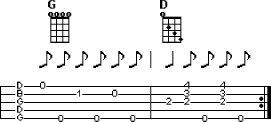A Book Of Five Strings - online tutorial
Strategies for mastering the art of old time banjo.
| Share page | Visit Us On FB |
|
Example Three |
||
|
|
||
 |
||
|
|
||
|
In this example we are using the double thumb in the first measure and a basic frailing pattern over a D chord in the second measure.
The count is 1& 2& 3&, 1 2& 3&. |
||
|
6/8 Time
In 6/8 time we are playing six eighth notes in every measure with the eighth note getting the beat. 6/8 is also a triplet time. That means that your eighth notes are in groups of three so you count for each measure is 1 2 3 2 2 3.
This is entirely different from 4/4 time where we are counting 1 2 3 4 in each measure. In 6/8 we are counting two three beat patterns in each measure.
Because of that, and because we are working with eighth notes rather than quarter notes, we can't effectively use the basic frailing strum in 6/8 time. We have to come up with something different. |
||
|
Example One |
||
|
|
||
 |
||
|
|
||
|
In this example we have a measure in 6/8 time. The note sequence is an eighth note followed by four sixteenth notes. A sixteenth note is one half the value of an eighth note so our count becomes 1 2& 3& 2 2& 3&.
I am using sixteenth notes here because it helps to put the emphasis on the first eighth note in each group of three. Just running six eighth notes right off the bat would make it difficult to get the feel of this rhythm pattern.
This is another pattern where practicing with the proper picking hand technique really pays off. The sixteenth notes just don't leave you any time to fish around for a string. |
||
|
|
||